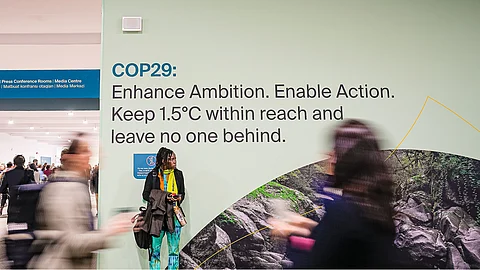

The Intergovernmental Panel on Climate Change (IPCC) has shortlisted a set of technologies for removing greenhouse gases from the atmosphere, to be considered in its special report expected by the end of 2027, experts revealed at an event hosted during 29th Conference of Parties (COP29) to the United Nations Framework Convention on Climate Change.
In January 2024, the IPCC tasked the Task Force on National Greenhouse Gas Inventories (TFI) with producing an internationally agreed Methodology Report on Carbon Dioxide Removal (CDR) Technologies and Carbon Capture, Utilisation and Storage (CCUS). The TFI, a body established by the IPCC, develops and refines methodologies and software for estimating and reporting national greenhouse gas emissions and removals.
CDR refers to methods that remove carbon dioxide from the atmosphere and durably store it through human intervention, explained Sandro Federici, head of the TFI technical support unit, at COP29. An example is direct air capture with geological storage, which involves capturing carbon dioxide (CO₂) from the atmosphere and injecting it into rocks at depths of 1–2.5 kilometres below the Earth’s surface.
However, capturing CO₂ from a fossil fuel extraction facility does not remove the gas from the atmosphere. Federici also noted that direct air capture of CO₂, later converted into a product such as methanol and used as fuel, does not qualify as CDR.
CCUS involves capturing CO₂, typically from large point sources like power generation or industrial facilities using fossil fuels or biomass as fuel, according to the International Energy Agency. “What can you do with captured CO₂ – produce beverage, brick or fuel. There are various utilisations. We need to focus on emissions and inventories of emissions,” Federici explained.
Currently, nations rely on the 2006 guidelines for preparing national inventories — estimates of greenhouse gas (GHG) emissions and removals from specific sources. These guidelines include methods for estimating emissions from carbon capture, utilisation and storage activities.
IPCC methodological guidance is already available for activities like afforestation, reforestation, soil carbon sequestration in grasslands or croplands, peatland and wetland restoration, agroforestry, improved forest management, biochar (a form of charcoal created by heating biomass without oxygen at temperatures of 400 degrees Celsius or higher) and Bioenergy with Carbon Capture and Storage (BECCS). BECCS involves capturing and permanently storing CO₂ from processes where biomass is converted into fuel or directly burned for energy.
Two decades on, the IPCC is now considering new methods for future national inventories to reflect emerging carbon dioxide removal technologies and new data on relevant sources (processes that absorb CO₂ from the atmosphere) and sinks (processes that predominantly absorb CO₂).
The special report comes after the IPCC Working Group III (WGIII) contribution to the Sixth Assessment Report (AR6) stated: “The deployment of carbon dioxide removal (CDR) to counterbalance hard-to-abate residual emissions is unavoidable if net zero CO₂ or GHG emissions are to be achieved”. The WGIII focuses on climate change mitigation, assessing methods for reducing greenhouse gas emissions and removing greenhouse gases from the atmosphere.
To date, the TFI has held an expert group meeting in July and a scoping meeting in October this year. The expert meeting discussed various CDR and CCUS activities, their coverage under IPCC guidelines and methodological challenges in estimating and reporting carbon dioxide removals.
“The scoping meeting, experts shortlisted areas that need methodological work. In the next IPCC session, the 62nd session in February 2025, the IPCC will decide which CDR technologies that need to be worked on. The IPCC might make some changes. Then, there will task authors to produce methodologies,” Federici told Down To Earth at an event during COP29.
The scoping meeting also made recommendations regarding the title and format of the monitoring report, its table of contents, instructions and workplan. These outputs were considered by the TFI Bureau (TFB), which advises the TFI.
The TFB is preparing a proposal for the methodology report to present to the IPCC panel during its 62nd session in February 2025. The IPCC is expected to adopt the outline and workplan for the methodology then.